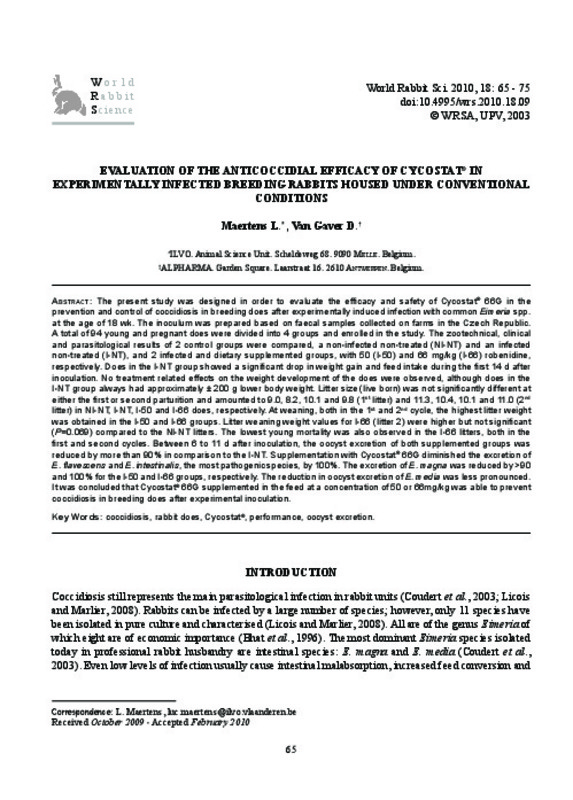JavaScript is disabled for your browser. Some features of this site may not work without it.
Buscar en RiuNet
Listar
Mi cuenta
Estadísticas
Ayuda RiuNet
Admin. UPV
Evaluation of the anticoccidial efficacy of Cycostat (R) in experimentally infected breeding rabbits housed under conventional conditions
Mostrar el registro sencillo del ítem
Ficheros en el ítem
| dc.contributor.author | Maertens, L.
|
|
| dc.contributor.author | Van Gaver, D.
|
|
| dc.date.accessioned | 2010-07-15T09:31:39Z | |
| dc.date.available | 2010-07-15T09:31:39Z | |
| dc.date.issued | 2010 | |
| dc.identifier.issn | 1257-5011 | |
| dc.identifier.uri | http://hdl.handle.net/10251/8432 | |
| dc.description.abstract | The present study was designed in order to evaluate the effi cacy and safety of Cycostat (R) 66G in the prevention and control of coccidiosis in breeding does after experimentally induced infection with common Eimeria spp. at the age of 18 wk. The inoculum was prepared based on faecal samples collected on farms in the Czech Republic. A total of 94 young and pregnant does were divided into 4 groups and enrolled in the study. The zootechnical, clinical and parasitological results of 2 control groups were compared, a non-infected non-treated (NI-NT) and an infected non-treated (I-NT), and 2 infected and dietary supplemented groups, with 50 (I-50) and 66 mg/kg (I-66) robenidine, respectively. Does in the I-NT group showed a significant drop in weight gain and feed intake during the fi rst 14 d after inoculation. No treatment related effects on the weight development of the does were observed, although does in the I-NT group always had approximately ± 200 g lower body weight. Litter size (live born) was not signifi cantly different at either the fi rst or second parturition and amounted to 9.0, 8.2, 10.1 and 9.8 (1st litter) and 11.3, 10.4, 10.1 and 11.0 (2nd litter) in NI-NT, I-NT, I-50 and I-66 does, respectively. At weaning, both in the 1st and 2nd cycle, the highest litter weight was obtained in the I-50 and I-66 groups. Litter weaning weight values for I-66 (litter 2) were higher but not significant (P=0.069) compared to the NI-NT litters. The lowest young mortality was also observed in the I-66 litters, both in the first and second cycles. Between 6 to 11 d after inoculation, the oocyst excretion of both supplemented groups was reduced by more than 90% in comparison to the I-NT. Supplementation with Cycostat (R) 66G diminished the excretion of E. flavescens and E. intestinalis, the most pathogenic species, by 100%. The excretion of E. magna was reduced by >90 and 100% for the I-50 and I-66 groups, respectively. The reduction in oocyst excretion of E. media was less pronounced. It was concluded that Cycostat (R) 66G supplemented in the feed at a concentration of 50 or 66mg/kg was able to prevent coccidiosis in breeding does after experimental inoculation. | en_EN |
| dc.language | Inglés | en_EN |
| dc.publisher | World Rabbit Science. ICTA. UPV | en_EN |
| dc.relation.ispartof | World Rabbit Science | |
| dc.rights | Reserva de todos los derechos | es_ES |
| dc.subject | Cycostat (R) | en_EN |
| dc.subject | Oocyst excretion | en_EN |
| dc.subject | Performance | en_EN |
| dc.subject | Cycostat | en_EN |
| dc.subject | Rabbit does | en_EN |
| dc.subject | Coccidiosis | en_EN |
| dc.title | Evaluation of the anticoccidial efficacy of Cycostat (R) in experimentally infected breeding rabbits housed under conventional conditions | en_EN |
| dc.type | Artículo | en_EN |
| dc.identifier.doi | 10.4995/wrs.2010.18.09 | en_EN |
| dc.rights.accessRights | Abierto | es_ES |
| dc.description.bibliographicCitation | Maertens, L.; Van Gaver, D. (2010). Evaluation of the anticoccidial efficacy of Cycostat (R) in experimentally infected breeding rabbits housed under conventional conditions. World Rabbit Science. 18(2). https://doi.org/10.4995/wrs.2010.18.09 | es_ES |
| dc.relation.publisherversion | https://doi.org/10.4995/wrs.2010.18.09 | es_ES |
| dc.description.volume | 18 | |
| dc.description.issue | 2 | |
| dc.identifier.eissn | 1989-8886 | es_ES |








